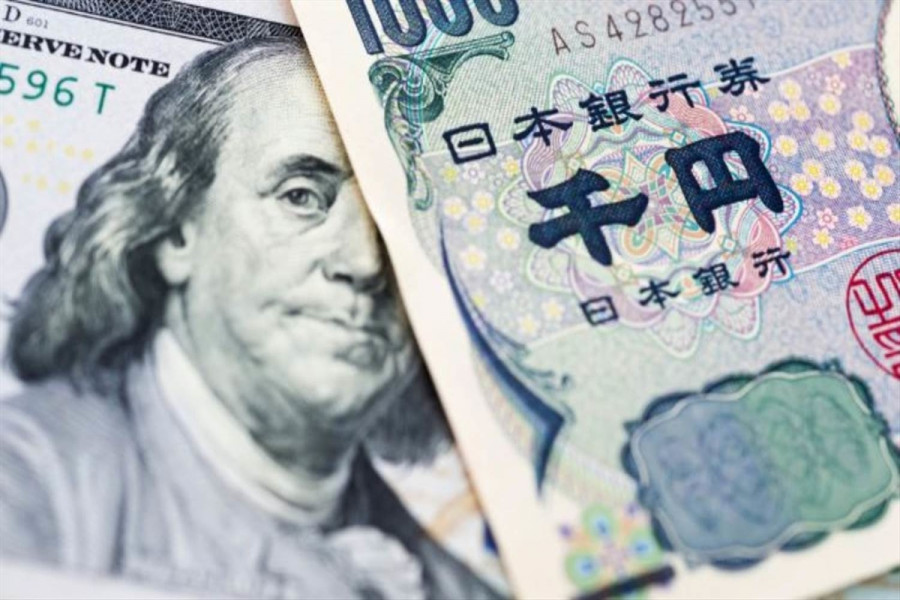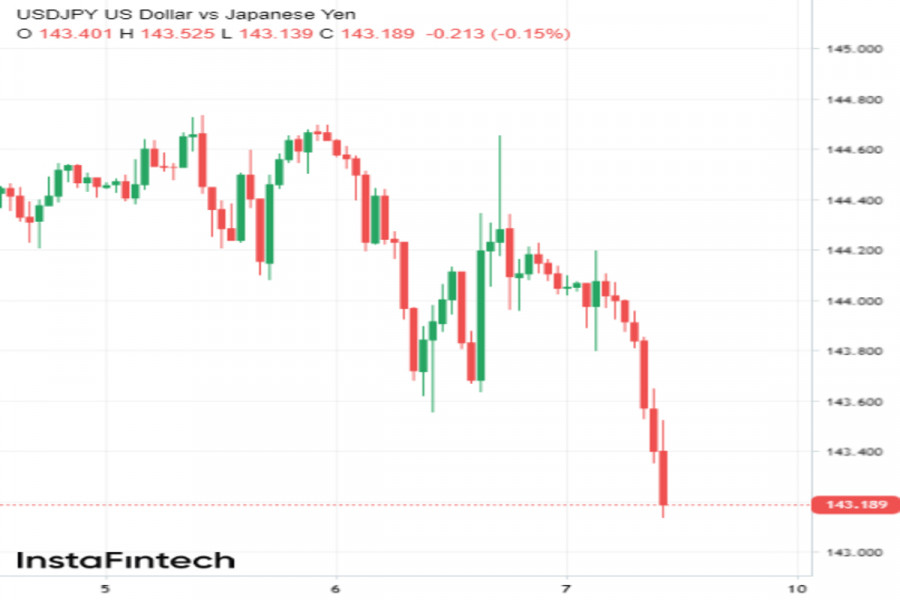On Friday morning, the dollar/yen pair continued its downward trajectory from yesterday when it fell by almost 0.4%. The drop came despite strong labor market data from the United States which reinforced traders' hawkish expectations regarding the future policy of the Federal Reserve. What is the main obstacle for the dollar/yen pair and is there a chance to resume growth?
JPY relies on monetary changes
Last Thursday, the USD/JPY pair reached an intraday low of 143.56 which is 1.4% lower than the high of the previous week.
Just a week ago, the pair was trading at 145.07, its highest level since November 2022. The price was able to touch this peak driven by increased market concerns about a deepening monetary divergence between the United States and Japan.
Despite the pause in the current tightening cycle in June, the Federal Reserve continues to maintain a hawkish stance and intends to raise interest rates at its upcoming meetings.
The Bank of Japan, on the other hand, remains committed to its current monetary policy which implies negative interest rates and has no plans to change it in the foreseeable future.
As we can see, the current fundamental background still favors the dollar bulls. So why did they lose control this week?
One bearish factor for USD/JPY at the moment is the risk of intervention. Last year, Japan intervened in the currency market twice to support its currency when the yen fell to 145.90 against the dollar.
When JPY approached dangerous levels last week, Tokyo did not take such extreme measures but issued threats against speculators who are actively selling the yen.
Warnings of intervention caused a downward correction in USD/JPY. However, the real blow to the asset came from growing speculations about imminent changes in the BOJ's monetary policy.
The reason for these talks was the income and wage data in Japan.
Last Wednesday, the country's largest labor union Rengo reported that many Japanese companies had agreed to raise average wages by 3.58% this year, the highest level since 1993.
BOJ Governor Kazuo Ueda has repeatedly stated that he sees wage growth as a key indicator to consider when discussing possible changes to monetary policy.
"If nominal wages in Japan increase from 3% to 3.5%, it will likely allow inflation to stabilize at the target level of 2%, which will prompt the abandoning of BOJ's ultra-loose policy," said Dr. Hisashi Yamada, an economics professor at Hosei University.
Speculation about monetary changes in Japan has also strengthened following today's publication of wage data, which exerted significant pressure on the USD/JPY pair. At the time of writing, the exchange rate declined by 0.4% and once again hit the previous daily low of 143.5.
Early on Friday, Japan's Ministry of Labor reported that in May, nominal cash earnings for Japanese workers increased by 2.5% from the previous year, exceeding economists' estimates of 1.2%.
As we can see, the annual "shunto" bargaining has borne fruit, with basic wages in Japan showing solid growth. Some experts believe that this may prompt the BOJ to consider adjusting its YCC policy sooner, without waiting for wage negotiations in 2024.
If the Bank of Japan does decide to change the yield curve control mechanism at its upcoming meeting in July, it will be interpreted by investors as the first hawkish shift. In that case, the dollar/yen pair may depreciate further.
USD has all the power
Despite growing speculations about imminent changes in the monetary policy of the Japanese central bank, most analysts currently believe that BOJ will not make any changes to its current policy, including YCC adjustment, until the end of the year.
"We do not think that a set of wage data for just one month will convince the Bank of Japan that the chances of reaching the inflation target have significantly increased. Most likely, the regulator will need much more time and data for that," shared Bloomberg economist Taro Kimura.
Further supporting the idea that the regulator will not rush to make decisions is today's comment from BOJ Deputy Governor Shinichi Uchida. This morning, the official stated that there is no urgent need to adjust its yield curve control policy in the near term.
"If the Japanese central bank does not take any hawkish steps in July, it will lead to further weakness in the yen against the dollar amid ongoing tightening in the United States," according to analysts at MUFG Bank.
Currently, futures markets are assessing the probability of the US regulator resuming interest rate hikes this month at over 92% compared to 87% the day before.
The strengthening of the market's hawkish expectations regarding the Fed's future tactics was supported by yesterday's employment data from ADP. The release showed that the number of jobs in the private sector increased by 497,000 last month, significantly exceeding the forecasts and surpassing the May reading of 267,000.
"The strong data not only raised market expectations for the rate hike in July but also significantly increased the likelihood of another round of tightening in the US, which was not previously considered by market participants," said Carol Kong, a currency strategist at Commonwealth Bank of Australia.
According to the expert, the ADP data brings hope that the key report of the week, the June NFP (Nonfarm Payrolls), may also surpass consensus estimates and show significant job growth in the US labor market.
Currently, economists expect the US economy to have added 225,000 jobs in June. However, if we see another strong result today, it could strengthen the US dollar across the board, including against the yen.
"The divergence in monetary policy between the US and Japan will stay the main driving force for the USD/JPY pair this year," said former Vice Minister of Finance of Japan Eisuke Sakakibara in an interview yesterday.
According to his forecasts, the Japanese currency will weaken by another 10% against the dollar this year as the Federal Reserve continues to raise rates while the Bank of Japan maintains its status quo. In such a scenario, the yen could end the year at around 160 against the dollar.
In 2022, Mr. Sakakibara was the first to predict the decline of JPY to 150 against the dollar. The expert gave a negative forecast back in the spring when the USD/JPY pair was trading around 131. A couple of months later, its exchange rate surged to 150, the highest level in 32 years.



























